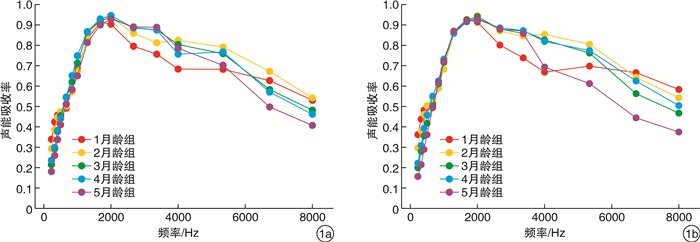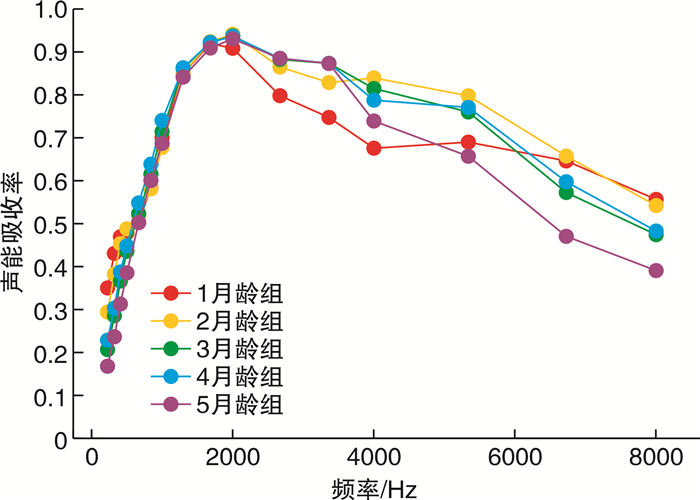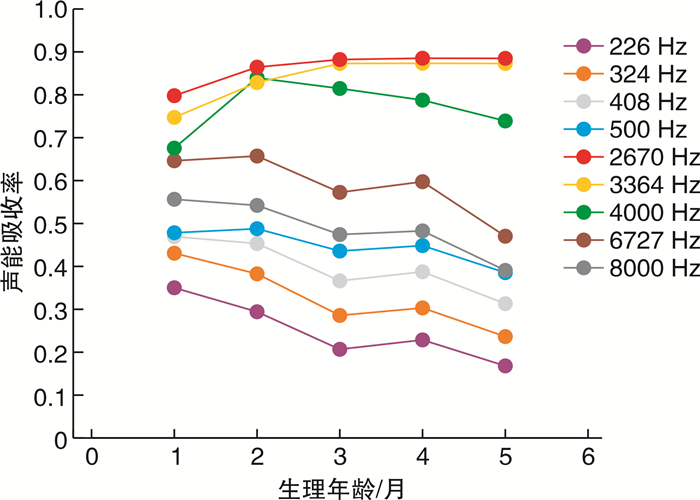A preliminary study on wideband acoustic immittance of infants with normal bilateral middle ear function at the age of 1-5 months
-
摘要: 目的 对1~5月龄双侧中耳功能正常的婴儿宽频声导抗(WAI)值特征进行初步探讨,以期有助于WAI测试技术在婴儿中耳功能评估中的临床运用。方法 纳入1~5月龄婴儿,在耳声发射和高频声导抗测试判定双侧中耳功能正常后进行WAI测试并收集分析测试数据。结果 各月龄组儿童左右耳间相同频率点的声能吸收率差异无统计学意义(P>0.05);4000 Hz的声能吸收率随着生理年龄的增长出现先上升后下降的现象,其余频率的声能吸收率除2670 Hz和3364 Hz以外均呈现下降现象。结论 研究结果表明需要建立国内1~5月龄中耳功能正常婴儿的声能吸收率正常值。中耳系统在出生后1~5月内的发育是为了保证言语频率范围的声音能够更有效地传导和聆听。Abstract: Objective To explore preliminary characteristics of wideband acoustic immittance of 1- to 5-month-old infants who have bilateral normal middle ear function, so as to contribute to the clinical application of WAI test in the evaluation of middle ear function in infants.Methods 1- to 5-month-old infants were included. After the normal function of bilateral middle ear was determined by otoacoustic emission and high frequency acoustic immittance test, WAI test was performed and the relevant data were collected and analyzed.Results There was no statistical difference in absorbance at the same frequency between the left ear and right ear of each group(P>0.05). Absorbance of 4000 Hz increased at first and then decreased with the growth of physiological age, and the sound energy absorption rate of other frequencies decreased except 2670 Hz and 3364 Hz.Conclusion The outcome of this study shows that it is necessary to establish the national normal value of WAI in 1- to 5-month-old infants who have bilateral normal middle ear function. The purpose of the development of middle ear system is to ensure that sounds in the speech frequency range can be transmitted and heard more effectively.
-
Key words:
- infant /
- middle ear /
- wideband acoustic immittance
-

-
表 1 各个月龄组儿童间相同频率点的声能吸收率比较结果(具有统计学差异)
组别比较 声能吸收率有统计学差异(P < 0.05)的频率/Hz 1月龄组与2月龄组 4000 1月龄组与3月龄组 226 324 408 2670 3364 4000 1月龄组与4月龄组 226 324 408 2670 3364 1月龄组与5月龄组 226 324 408 500 3364 6727 8000 2月龄组与3月龄组 226 324 408 2月龄组与5月龄组 226 324 408 500 6727 8000 -
[1] Keefe DH, Bulen JC, Arehart KH, et al. Ear-canal impedance and reflection coefficient in human infants and adults[J]. J Acoust Soc Am, 1993, 94(5): 2617-2638. doi: 10.1121/1.407347
[2] Voss SE, Allen JB. Measurement of acoustic impedance and reflectance in the human ear canal[J]. J Acoust Soc Am, 1994, 95(1): 372-384. doi: 10.1121/1.408329
[3] Stuppert L, Nospes S, Bohnert A, et al. Clinical benefit of wideband-tympanometry: a pediatric audiology clinical study[J]. Eur Arch Otorhinolaryngol, 2019, 276(9): 2433-2439. doi: 10.1007/s00405-019-05498-2
[4] Kei J, Sanford CA, Prieve BA, et al. Wideband acoustic immittance measures: developmental characteristics(0 to 12 months)[J]. Ear Hear, 2013, 34 Suppl 1: 17S-26S.
[5] Aithal S, Kei J, Driscoll C. Wideband absorbance in young infants(0-6 months): a cross-sectional study[J]. J Am Acad Audiol, 2014, 25(5): 471-481. doi: 10.3766/jaaa.25.5.6
[6] Aithal S, Kei J, Aithal V, et al. Normative Study of Wideband Acoustic Immittance Measures in Newborn Infants[J]. J Speech Lang Hear Res, 2017, 60(5): 1417-1426. doi: 10.1044/2016_JSLHR-H-16-0237
[7] Wali HA, Mazlan R, Kei J. A Longitudinal Analysis of Pressurized Wideband Absorbance Measures in Healthy Young Infants[J]. Ear Hear, 2019, 40(5): 1233-1241. doi: 10.1097/AUD.0000000000000707
[8] Hunter LL, Keefe DH, Feeney MP, et al. Longitudinal development of wideband reflectance tympanometry in normal and at-risk infants[J]. Hear Res, 2016, 340: 3-14. doi: 10.1016/j.heares.2015.12.014
[9] 亓贝尔, 刘佳星, 文铖, 等. 听力正常新生儿宽频声导抗特征值初探[J]. 临床耳鼻咽喉头颈外科杂志, 2018, 32(4): 244-249. http://lceh.cbpt.cnki.net/WKC/WebPublication/paperDigest.aspx?paperID=e0374ce8-1870-44a5-9128-21d0fb910cf2
[10] 彭珊, 郑芸, 陈漫琳, 等. 1~2月龄中耳功能正常婴儿宽频声导抗声能吸收率值特征初探[J]. 听力学及言语疾病杂志, 2022, 30(3): 312-314. https://www.cnki.com.cn/Article/CJFDTOTAL-TLXJ202203017.htm
[11] American Academy of Pediatrics, Joint Committee on Infant Hearing. Year 2007 position statement: Principles and guidelines for early hearing detection and intervention programs[J]. Pediatrics, 2007, 120(4): 898-921. doi: 10.1542/peds.2007-2333
[12] Shahnaz N, Cai A, Qi L. Understanding the developmental course of the acoustic properties of the human outer and middle ear over the first 6 months of life by using a longitudinal analysis of power reflectance at ambient pressure[J]. J Am Acad Audiol, 2014, 25(5): 495-511. doi: 10.3766/jaaa.25.5.8
[13] Hu XJ, Li FF, Lau CC. Development of the Mandarin speech banana[J]. Int J Speech Lang Pathol, 2019, 21(4): 404-411. doi: 10.1080/17549507.2018.1485741
-





 下载:
下载:

